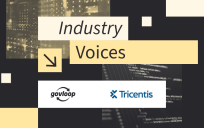Before agencies can modernize, they need to assess the viability of their underlying infrastructure to power new innovations, applications, and services. But traditional environments are often crowded with hardware-defined legacy systems – usually operating in silos.
Moving to a software-defined, hyperconverged infrastructure model will consolidate, streamline and redefine government data centers for modern requirements. We’ll explain why this approach is explicitly required for modernization in our last lesson. But for now, let’s discuss what a hyperconverged infrastructure platform is and why it’s beneficial to agency IT.
Hyperconvergence is a software-defined approach of consolidating compute, storage, and networking into a single tier of infrastructure. It replaces all the components that run in large, legacy data centers with software. That software allows users to point-and-click to perform upgrades, patches, provisioning, retiring, and other functions of a technology lifecycle.
This setup comes with inherent benefits to agencies. With hyperconvergenence, they can consolidate the physical footprint of IT, and make measurable progress against the goals of the DCOI. Separate servers, storage networks and storage arrays can be replaced by a single hyperconverged platform that consumes far less space, power and cooling.
Additionally, because some hypconverged platforms are 100% software-defined, they are built to scale to any size environment. Each instance acts as a building block and resources can be added on demand, depending on the specific requirements of the agency. You can add more compute or storage as your organization needs more resources, or you can scale back if demand declines.
The cost model of software-driven data centers enables agencies to begin with incremental investments, rather than risky large capital expenditures up front. Then they can grow to any size deployment. Plus, scaling is far easier, as some platforms can be provisioned within minutes or hours, rather than the weeks or months it would take to procure and provision traditional hardware.
Upgrades and maintance also become easier. Because all these capabilities are managed from a single, scalable platform, an IT admin can execute software updates with one click and reduce or even eliminate planned IT downtime. That diminishes the time IT needs to spend on turnkey tasks, freeing them up to focus on more strategic goals.
Finally, hyperconverged solutions are fault-resistent. While compute, storage, and networking are managed centrally, hyperconvergence uses a distributed storage fabric to ensure there is no single point of failure or bottlenecks. Agencies don’t have to worry about losing access to their data or applications, as they often do with traditional data center setups.
Ultimately, hyperconverged infrastructure provides many capabilities that agencies seek from cloud, like agility, scalability and rapid-deployments, but without sacrificing security or governance. Hyperconverged infrastructure can free organizations from burdensome hardware refresh cycles, and make government agencies the boss of their IT again, while reducing costs and increasing efficiencies. It also sets agencies up for true modernization.

To learn more about how hyperconverged infrastructure can set agencies up for cloud migration and, ultimately, IT modernization success, check out our 10-minute, on-demand course on GovLoop Academy.





Leave a Reply
You must be logged in to post a comment.